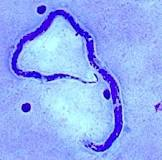Loiasis
PKGhatak, MD.
Loiasis is a human parasitic disease produced by a nematode - Loa loa. It belongs to the Filaria group of round worms. Loiasis is endemic to 11 counties of Central and West Africa. In the rainy season, the disease activity is maximum, which coincides with the breeding season of the Chrysops fly. The fly is a deer fly, locally known as Mango fly or Mangrove fly.
20 million people are at risk of Loiasis and annual incidence is 3 to 10 million. The illness was thought to be benign, now, that is questioned by the finding that the mortality reaches 14 % in local areas where parasitemia is unusually high – over 30,000 microfilaria /ml of blood. Another worm disease, Onchocerciasis, is also endemic in several countries in the very area; and the treatment of Onchocerca by Ivermectin leads to the development of encephalitis and deaths of unsuspected patients having both these two diseases simultaneously.
The first case of Loiasis was reported from San Domingo in 1770, by a French surgeon Mongin who saw the Loa loa worm in the eye of a woman but was unsuccessful in removing it.
The Chrysops fly is unusually aggressive and determined. It lacerates the skin of its victim with its sharp saw like proboscis and then licks the blood from the wound. The bites are quite painful and attempts to drive the fly away, lead to more bites by the same determined fly, who must have a bloody meal for her egg development.
The life cycle of Loa loa:
In the gut of the fly, blood containing microfilaria undergoes development to a 3rd stage of infective microfilaria and in 10 days the microfilaria moves to the proboscis of the fly and is ready to begin its life in humans.
The skin wound and the draining lymph nodes swell and become tender. In 6 months to a year, the worm becomes an adult. The adult worm moves around in the subcutaneous tissue and the sexually mature worms unite and the female worm gives birth to about 20,000 microfilaria every day. The microfilaria move into the pulmonary circulation, and from the lungs, they enter the systemic circulation every day during 10 AM and 3 PM. There they wait for the fly bite and begin their lives inside the fly. Then the cycle repeats. An adult worm can live up to 15 years.
Symptoms produced by the parasite:
Both the adult worm and microfilaria are allergenic to humans.
Most victims, however, are asymptomatic. Generalized itching, urticaria, recurrent muscle and joint pain and tender lumps on the skin over the underlying worm develop. These lumps are common around the knees, ankles and other joints and are called Calabar swellings. The migrating adult worm in the subconjunctiva of the eye and eyelids is a characteristic feature of Loiasis and is an African Eye Worm Disease. Adult worm in the eyes occasionally enters the vitreous humor of the eye, and secondary infection may lead to blindness. The risk of encephalitis when Invective is given is not to be underestimated.
Diagnosis requires visualization of Microfilaria in the blood, collected during daytime, and blood smears are stained with Giemsa stain. Serological tests and PCR antigen recognition tests are neither locally available nor standardized.
Treatment: Three medications, namely, Diethylcarbamazine, Albendazole, Ivermectin, are used in the elimination of both the adult worms and microfilaria. The selection of a particular drug based on the microfilaria load, the patient's symptoms, and allergic history.
**************************************



No comments:
Post a Comment